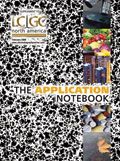Using Solid Phase Microextraction with AccuTOF-DART™ for Fragrance Analysis
Solid phase microextraction (SPME) is a well established sampling technique that is often used to isolate volatile organic components in gaseous mixtures.
Solid phase microextraction (SPME) is a well established sampling technique that is often used to isolate volatile organic components in gaseous mixtures. Once the compounds have been collected, the SPME fibers are typically placed into a heated GC inlet which thermally desorbs these components into a GC–MS system for analysis. Normally, this analysis can take between 10–30 min to complete depending on the complexity of the samples. In this work, the Direct Analysis in Real Time (DART™ ) heated gas stream is used to desorb and directly introduce a SPME sample into a high-resolution mass spectrometer. This methodology produces comparable information to the traditional GC–MS technique, but streamlines the results into only a few seconds of analysis time.
Experimental
A Supelco DVB/Carboxen/PDMS StableFlex SPME fiber was placed in an enclosed plastic bag with a banana for 10 min during each analysis. For direct analysis of the SPME fiber, the JEOL AccuTOF-DART™ system was set to the following parameters: needle voltage 3500V, discharge electrode 150V, grid electrode 250V, helium temperature 200 °C, and helium flowrate 2.3 L/min. A JEOL GC-Mate II high resolution sector bench top system equipped with a DB5-HT (0.25mm × 30m) was used for the GC–MS portion of the analysis. The GC-Mate II was set to the following parameters: inlet temperature 250 °C, split ratio 30, and helium flowrate 1.2 mL/min. The GC oven was set for the following temperature profile: 40 °C held for 2 min, ramp from 40 to 260 °C at 20 °C/min, 260 °C held for 2 min.

Figure 1: AccuTOF-DART mass spectrum for banana fragrances from SPME fiber.
Results and Conclusions
Figure 1 shows a typical AccuTOF-DART™ mass spectrum obtained for a banana headspace sample. At first glance, this spectrum might appear complex, but using the JEOL-provided ChemSW Search from List Software, all of the [M+H]+ , [M+NH4]+ , and [2M+H]+ for each alcohol, acetate, and butyrate were identified, summed together, and normalized in a matter of seconds. Additionally, these results were directly comparable to the data obtained for the traditional GC–MS analysis done using the GC-Mate II. Figure 2 shows a side-by-side comparison of these data sets. This work clearly demonstrates that the AccuTOF-DART™ can be used with SPME to quickly produce results that are comparable to traditional analysis techniques.

Figure 2: Comparison of relative abundances observed for each compound using GCâMS and DART-MS analysis.

JEOL USA, Inc.
11 Dearborn Road, Peabody, MA 01960
tel. (978)535-5900, fax (978)536-2205
Website: www.jeolusa.com

Free Poster: NDSRI Risk Assessment and Trace-Level Analysis of N-Nitrosamines
April 25th 2025With increasing concern over genotoxic nitrosamine contaminants, regulatory bodies like the FDA and EMA have introduced strict guidelines following several high-profile drug recalls. This poster showcases a case study where LGC and Waters developed a UPLC/MS/MS method for quantifying trace levels of N-nitroso-sertraline in sertraline using Waters mass spectrometry and LGC reference standards.
New TRC Facility Accelerates Innovation and Delivery
April 25th 2025We’ve expanded our capabilities with a state-of-the-art, 200,000 sq ft TRC facility in Toronto, completed in 2024 and staffed by over 100 PhD- and MSc-level scientists. This investment enables the development of more innovative compounds, a broader catalogue and custom offering, and streamlined operations for faster delivery. • Our extensive range of over 100,000 high-quality research chemicals—including APIs, metabolites, and impurities in both native and stable isotope-labelled forms—provides essential tools for uncovering molecular disease mechanisms and exploring new opportunities for therapeutic intervention.
New Guide: Characterising Impurity Standards – What Defines “Good Enough?”
April 25th 2025Impurity reference standards (IRSs) are essential for accurately identifying and quantifying impurities in pharmaceutical development and manufacturing. Yet, with limited regulatory guidance on how much characterisation is truly required for different applications, selecting the right standard can be challenging. To help, LGC has developed a new interactive multimedia guide, packed with expert insights to support your decision-making and give you greater confidence when choosing the right IRS for your specific needs.
Using the Carcinogenic Potency Categorisation Approach (CPCA) to Classify N-nitrosamine Impurities
April 25th 2025Learn how to manage nitrosamine impurities in pharmaceuticals with our free infographic. Discover how the CPCA approach establishes acceptable intake limits and guides the selection of NDSRI reference samples. Stay compliant and ensure safety with our ISO-accredited standards.

.png&w=3840&q=75)

.png&w=3840&q=75)



.png&w=3840&q=75)



.png&w=3840&q=75)














